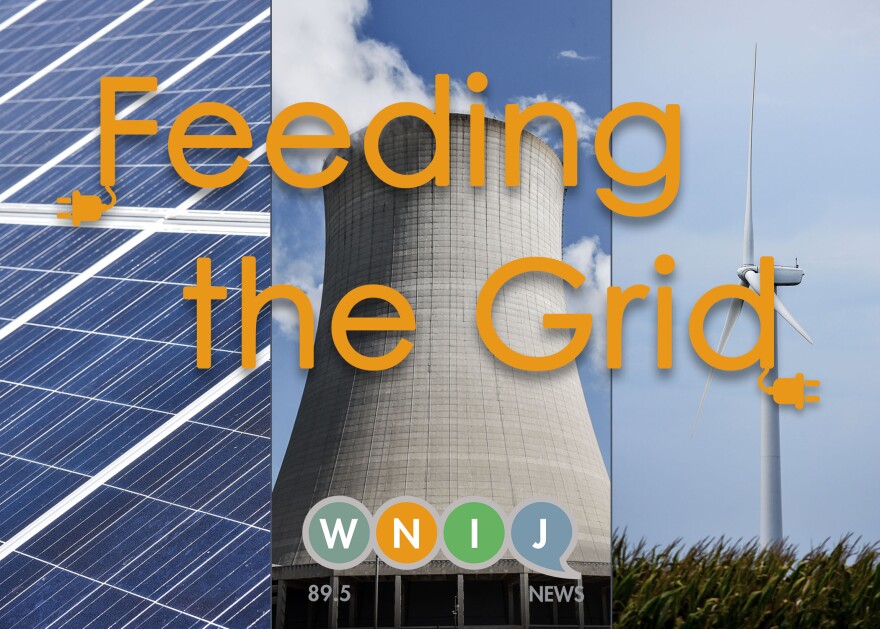Wind, solar, and nuclear are some of the energy options available to Illinois consumers. This week on Morning Edition, the WNIJ news team explores how these affect the quality of life in northern Illinois in 2018 and beyond.
Wind: The "Third Crop"
Wind is sometimes called the "third crop" by farmers.
Reporter Susan Stephens has been following the development of wind farms in northern Illinois. She says the term is used because so often the turbines are placed on farms.

"And the farmers can make quite a bit of money too by allowing a wind farm to be sited, or a wind turbine to be sited, on their property," Stephens explains.
There are several concerns behind wind technology.
Stephens says a lot of it comes from people who are not making money from the turbines--the neighbors.
"They don't want to see those big, giant turbines in their view whenever they want to look at the sunset," Stephens said. "Also, they do kill bats and birds. That's a given. It's just, you know, a matter of how much is worth the cleaner energy. Also the sound. They do make sound. And for some people, they find it really, really annoying and they have to kind of shore up their houses so they don't hear these sounds."
The timing for the opposition now is because DeKalb County is looking at creating its own wind ordinance, and they're moving to areas that are a little more populated. When they popped up in Lee County there were more farm areas and people were able to make money off them. Now there could be more people disturbed by them.
- You can learn more about wind energy in our series "Feeding the Grid" on Tuesday, Sept. 18th during Morning Edition on WNIJ.
Solar: Sunny Skies Could Bring Big Bucks To Illinois
Guy Stephens has been looking into the future of large-scale solar in Illinois. He says the main change is known as "community solar."

"What they're doing with community solar is they're setting up a whole system-- a whole market," he said.
"They" is the Illinois Power Agency, a state agency set up by the legislature to regulate the market.
Businesses are coming in to set up small solar arrays that could power several hundred homes. And they will take subscribers; that's where the "community" comes from.
According to Stephens, "You could subscribe and say, 'I want ten percent of the energy from this,' or, 'I want a quarter of the energy from this.'" Consumers would then get a credit on their electric bill for the amount of electricity they are using.
"The result is that you could see a lower overall electric bill because of the subscription to that solar array," Stephens said. "They're talking about dozens, hundreds, maybe even thousands of proposals, probably most of those won't get in just because there isn't enough money in the budget for all of them--at least this year. But in the next couple of years you could see small solar arrays dotted all over Illinois."
- You can learn more about solar energy in our series "Feeding the Grid" on Wednesday, Sept. 19th during Morning Edition on WNIJ.

Don’t Forget About Nuclear
Chase Cavanaugh toured the Exelon nuclear plant in Byron to get a better idea of how that type of energy is trying to stay competitive as wind and solar get more popular.
Unlike wind or solar, which depend on weather or the time of day, nuclear plants run 24/7 without having to store energy in batteries when they're not making power.
"They have enough uranium on hand, at least at the Byron plant, to run for eighteen months without any kind of interruptions," Cavanaugh explained. "So it's constant, continuous power that can act as a base for renewables to build off of."
- You can learn more about nuclear energy in our series "Feeding the Grid" on Thursday, Sept. 20th during Morning Edition on WNIJ.
Yes In My Backyard
Often, when there is a controversial measure that could affect someone's property, the acronym "NIMBY" is tossed around. It stands for "Not In My Backyard." In this case, some northern Illinois residents have fully embraced altering their terrain. Reporter Peter Medlin found some schools, businesses, even homeowners are opting to create smaller, do-it-yourself projects.
He toured a building at Naperville's North Central College. One of their buildings is big enough to include a residence hall and indoor track, so they were able to install about 1,600 solar panels in an array on the roof. These provide about 22 percent of the building's electricity. They also have geothermal for the building.

"Another one of the dorm rooms there, they have some solar thermal to heat the water. So they have all sorts of different sustainable measures and projects," Medlin said.
He also visited an Oregon, Ill., couple who transformed their property into a solar and wind destination.
- You can learn more about consumer level projects in our series "Feeding the Grid" on Friday, Sept. 21st during Morning Edition on WNIJ.
Our series does not focus specifically on coal. Why?
"Coal isn't necessarily neglected in it, it's just for northern Illinois coal isn't as big a part of the grid when it comes to generating power," Cavanaugh said.
Guy Stephens says for several years Illinois has had a goal of 25 percent of its power coming from renewables by the year 2025.
"So coal is not off anybody's chart, but it's not in the planning stages for any future endeavors," he said. "Coal may be in there, but it's gonna be a legacy. And it'll be about updating coal, or trying to clean up the coal plants that do exist."

